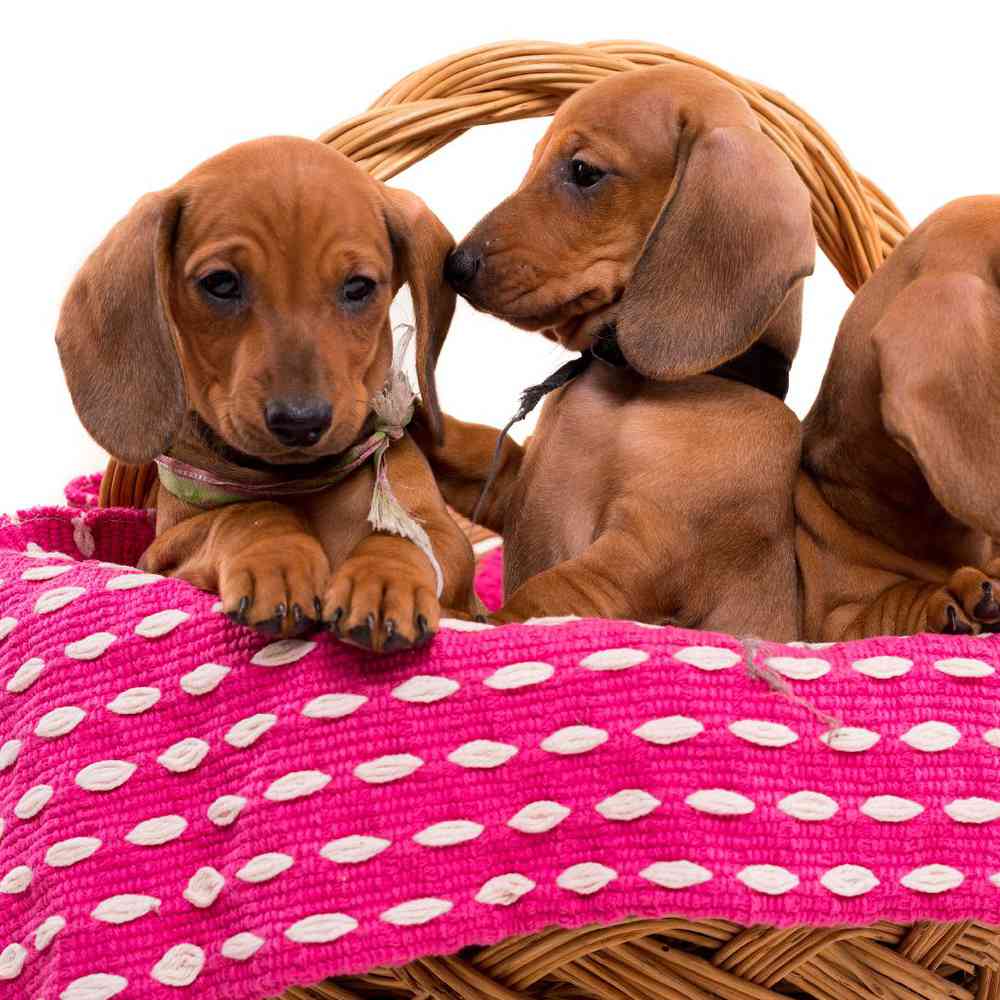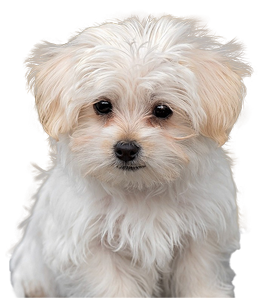
Apartment Friendly
AKC Registrable
Family Dog
Dachshund
The famously long, low silhouette, ever-alert expression, and bold, vivacious personality of the Dachshund have made him a superstar of the canine kingdom. Dachshunds come in two sizes and in three coat types of various colors and patterns.
Available Pups
Puppy Knowledge
Breed Info
Clubs, Registries & Associations
American Canine Association Continental Kennel Club Universal Kennel Club International American Kennel Club United All Breed Registry America's Pet Registry, Inc. United Kennel Club (Based on breed recognition. See store for details on this particular puppy.)
Group
Hound
Heritage
The Dachshund, a member of the hound group, was bred to scent, chase and drive out badgers and other hole-dwelling animals as well as to hunt prairie dogs. The Dachshund was first bred in the 17th century in Germany. There are three varieties of Dachshund: short-haired or smooth, long-haired and wire-haired. This review is about the short-haired or smooth Dachshund.
Description
Small, up to 8-11” at the shoulders, weighing up to 11 pounds. This breed is long, sturdy and muscular, with short and stubby legs. The paws are uncommonly large and paddle-shaped for efficient digging to force prey out of their burrows. The body skin is loose so not to tear while tunneling in tight spaces. The dachshund has a deep chest to accommodate lung capacity when hunting, with a long nose for increased scenting ability. The short, hard coat comes in solid colors of black, red, chocolate, tan, fawn, crème/wheaton, blue, bi-color variations, brindle variations, dapple variations, tri-color, and piebald.
Health Awareness
The Dachshund has a life expectancy of 12-15 years and is prone to eye disorders, spinal diseases, urinary tract infections, heart disease and diabetes. They also like to eat and easily gain weight, which puts increased pressure on a delicate spine.
Personality
The Dachshund is the tiny dog of courage. Bred to hunt alone, they are highly independent and can become overassertive and argumentative. This can make your training somewhat challenging. You need to be a calm, knowledgeable, and humane owner giving consistent and committed leadership to your Dachshund using only motivational training methods. They are bred to dig and burrow, so be ready to give your Dachshund a digging pit and teach him or her to use it. Your digging Dachshund will also like to burrow under your bedding, which is pretty cute. Wary of strangers, you will need to socialize your Dachshund, and then socialize more, to prevent any guarding issues from developing. This breed has high prey drive, likes to chase and roam, so a fence is necessary. This amusing, brave, alert, clever, and loving little dog is well worth your patient teaching to enjoy with wonderful little companion.
Exercise/Energy Level
The Dachshund is an active breed, and requires a daily walk and off-leash play and running in a safe, fenced area. They also need mental stimulation to prevent boredom and destruction, so be sure to provide your Dachshund with plenty of interactive toys that challenge their problem-solving skills. A bored Dachshund can develop anxiety and stress issues.
Additional Information
Grooming Requirements: Requires regular brushing and bathing Coat: Short Shedding: Average shedding Hypoallergenic: No, due to shedding Apartment Living: Good for apartment living if given sufficient exercise Lap Dog: Yes Good With Children: Best with older children who understand how to respect this small breed. They do not tolerate rough housing; can be unpredictable with children and even with unfamiliar adults. This breed needs a lot of socialization when a puppy. Good With Other Pets: Good with other dogs (especially other Dachshunds) when socialized while a puppy; not trustworthy with non-canine pets due to hunting instinct.
Breed Standard
General Appearance
Low to ground, long in body and short of leg, with robust muscular development; the skin is elastic and pliable without excessive wrinkling. Appearing neither crippled, awkward, nor cramped in his capacity for movement, the Dachshund is well-balanced with bold and confident head carriage and intelligent, alert facial expression. His hunting spirit, good nose, loud tongue and distinctive build make him well-suited for below-ground work and for beating the bush. His keen nose gives him an advantage over most other breeds for trailing. NOTE: Inasmuch as the Dachshund is a hunting dog, scars from honorable wounds shall not be considered a fault.
Size, Proportion, Substance
Bred and shown in two sizes, standard and miniature; miniatures are not a separate classification but compete in a class division for "11 pounds and under at 12 months of age and older." Weight of the standard size is usually between 16 and 32 pounds.
Head
Viewed from above or from the side, the head tapers uniformly to the tip of the nose. The eyes are of medium size, almond-shaped and dark-rimmed, with an energetic, pleasant expression; not piercing; very dark in color. The bridge bones over the eyes are strongly prominent. Wall eyes, except in the case of dappled dogs, are a serious fault. The ears are set near the top of the head, not too far forward, of moderate length, rounded, not narrow, pointed, or folded. Their carriage, when animated, is with the forward edge just touching the cheek so that the ears frame the face. The skull is slightly arched, neither too broad nor too narrow, and slopes gradually with little perceptible stop into the finely-formed, slightly arched muzzle, giving a Roman appearance. Lips are tightly stretched, well covering the lower jaw. Nostrils well open. Jaws opening wide and hinged well back of the eyes, with strongly developed bones and teeth. Teeth-Powerful canine teeth; teeth fit closely together in a scissors bite. An even bite is a minor fault. Any other deviation is a serious fault.
Neck, Topline, Body
Long, muscular, clean-cut, without dewlap, slightly arched in the nape, flowing gracefully into the shoulders without creating the impression of a right angle. The trunk is long and fully muscled. When viewed in profile, the back lies in the straightest possible line between the withers and the short, very slightly arched loin. A body that hangs loosely between the shoulders is a serious fault. Abdomen-Slightly drawn up.
Hindquarters
Strong and cleanly muscled. The pelvis, the thigh, the second thigh, and the rear pastern are ideally the same length and give the appearance of a series of right angles. From the rear, the thighs are strong and powerful. The legs turn neither in nor out. Rear pasterns - Short and strong, perpendicular to the second thigh bone. When viewed from behind, they are upright and parallel. Feet-Hind Paws - Smaller than the front paws with four compactly closed and arched toes with tough, thick pads. The entire foot points straight ahead and is balanced equally on the ball and not merely on the toes. Rear dewclaws should be removed. Croup- Long, rounded and full, sinking slightly toward the tail
Tail
Tail - Set in continuation of the spine, extending without kinks, twists, or pronounced curvature, and not carried too gaily.
Gait
Fluid and smooth. Forelegs reach well forward, without much lift, in unison with the driving action of hind legs. The correct shoulder assembly and well-fitted elbows allow the long, free stride in front. Viewed from the front, the legs do not move in exact parallel planes, but incline slightly inward. Hind legs drive on a line with the forelegs, with hock joints and rear pasterns (metatarsus) turning neither in nor out. The propulsion of the hind leg depends on the dog’s ability to carry the hind leg to complete extension. Viewed in profile, the forward reach of the hind leg equals the rear extension. The thrust of correct movement is seen when the rear pads are clearly exposed during rear extension. Rear feet do not reach upward toward the abdomen and there is no appearance of walking on the rear pasterns.Feet must travel parallel to the line of motion with no tendency to swing out, cross over, or interfere with each other. Short, choppy movement, rolling or high-stepping gait, close or overly wide coming or going are incorrect. The Dachshund must have agility, freedom of movement, and endurance to do the work for which he was developed.
Temperament
Friendly, Curious, Spunky
Coat
Special Characteristics of the Three Coat Varieties The Dachshund is bred with three varieties of coat: (1) Smooth; (2) Wirehaired; (3) Longhaired and is shown in two sizes, standard and miniature. All three varieties and both sizes must conform to the characteristics already specified. The following features are applicable for each variety: Smooth Dachshund Coat-Short, smooth and shining. Should be neither too long nor too thick. Ears not leathery. Tail-Gradually tapered to a point, well but not too richly haired. Long sleek bristles on the underside are considered a patch of strong-growing hair, not a fault. A brush tail is a fault, as is also a partly or wholly hairless tail. Color of Hair-Although base color is immaterial, certain patterns and basic colors predominate. One-colored Dachshunds include red and cream, with or without a shading of interspersed dark hairs. A small amount of white on the chest is acceptable, but not desirable. Nose and nails-black. Two-colored Dachshunds include black, chocolate, wild boar, gray (blue) and fawn (Isabella), each with deep, rich tan or cream markings over the eyes, on the sides of the jaw and underlip, on the inner edge of the ear, front, breast, sometimes on the throat, inside and behind the front legs, on the paws and around the anus, and from there to about one-third to one-half of the length of the tail on the underside. Undue prominence of tan or cream markings is undesirable. A small amount of white on the chest is acceptable but not desirable. Nose and nails-in the case of black dogs, black; for chocolate and all other colors, dark brown, but self-colored is acceptable. Dappled dachshunds-The dapple (merle) pattern is expressed as lighter-colored areas contrasting with the darker base color, which may be any acceptable color. Neither the light nor the dark color should predominate. Nose and nails are the same as for one- and two-colored Dachshunds. Partial or wholly blue (wall) eyes are as acceptable as dark eyes. A large area of white on the chest of a dapple is permissible. Brindle is a pattern (as opposed to a color) in which black or dark stripes occur over the entire body although in some specimens the pattern may be visible only in the tan points. Sable-the sable pattern consists of a uniform dark overlay on red dogs. The overlay hairs are double-pigmented, with the tip of each hair much darker than the base color. The pattern usually displays a widow’s peak on the head. Nose, nails and eye rims are black. Eyes are dark, the darker the better. Wirehaired Dachshunds Coat-With the exception of jaw, eyebrows, and ears, the whole body is covered with a uniform tight, short, thick, rough, hard, outer coat but with finer, somewhat softer, shorter hairs (undercoat) everywhere distributed between the coarser hairs. The absence of an undercoat is a fault. The distinctive facial furnishings include a beard and eyebrows. On the ears the hair is shorter than on the body, almost smooth. The general arrangement of the hair is such that the wirehaired Dachshund, when viewed from a distance, resembles the smooth. Any sort of soft hair in the outercoat, wherever found on the body, especially on the top of the head, is a fault. The same is true of long, curly, or wavy hair, or hair that sticks out irregularly in all directions. Tail-Robust, thickly haired, gradually tapering to a point. A flag tail is a fault. Color of Hair-While the most common colors are wild boar, black and tan, and various shades of red, all colors and patterns listed above are admissible. Wild boar (agouti) appears as banding of the individual hairs and imparts an overall grizzled effect which is most often seen on wirehaired Dachshunds, but may also appear on other coats. Tan points may or may not be evident. Variations include red boar and chocolate-and-tan boar. Nose, nails and eye rims are black on wild-boar and red-boar dachshunds. On chocolate-and-tan-boar dachshunds, nose, nails, eye rims and eyes are self-colored, the darker the better. A small amount of white on the chest, although acceptable, is not desirable. Nose and nails-same as for the smooth variety. Longhaired Dachshund Coat - The sleek, glistening, often slightly wavy hair is longer under the neck and on forechest, the underside of the body, the ears and behind the legs. The coat gives the dog an elegant appearance. Short hair on the ear is not desirable. Too profuse a coat which masks type, equally long hair over the whole body, a curly coat, or a pronounced parting on the back are faults. Tail-Carried gracefully in prolongation of the spine; the hair attains its greatest length here and forms a veritable flag. Color of Hair-Same as for the smooth Dachshund. Nose and nails-same as for the smooth. The foregoing description is that of the ideal Dachshund. Any deviation from the above described dog must be penalized to the extent of the deviation keeping in mind the importance of the contribution of the various features toward the basic original purpose of the breed.
Overview
About
The word “icon” is terribly overworked, but the Dachshund—with his unmistakable long-backed body, little legs, and big personality—is truly an icon of purebred dogdom. Dachshunds can be standard-sized (usually 16 to 32 pounds) or miniature (11 pounds or under), and come in one of three coat types: smooth, wirehaired, or longhaired. Dachshunds aren’t built for distance running, leaping, or strenuous swimming, but otherwise these tireless hounds are game for anything. Smart and vigilant, with a big-dog bark, they make fine watchdogs. Bred to be an independent hunter of dangerous prey, they can be brave to the point of rashness, and a bit stubborn, but their endearing nature and unique look has won millions of hearts the world over.
History
“Dachshund” is a German word meaning “badger dog,” and the breed’s German history goes back some 600 years. And, as the breed name suggests, the Dachshund was developed to enthusiastically dig his way into a badger den and dispatch its occupant. The Dachshund’s long, low body was custom-made for this dirty subterranean work. For a dog of any size, a badger is a formidable adversary, weighing anywhere from 25 to 40 pounds, with razor-sharp teeth and claws. The cleverness, courage, perseverance, and strength that are hallmarks of today’s Dachshund were first bred into his long-ago ancestors to best equip them for battling a deadly foe. The little dog’s surprisingly loud, houndy bark is also a throwback to his working roots: It allowed the Dachshund’s above-ground human hunting partner to mark his hound’s underground location. In addition to the breed’s short, smooth coat, selective breeding produced types with wire coats for work in thorny brier patches, and long coats for cold climates. Dachshunds of various sizes were bred to work on different kinds of quarry. Packs of Dachshunds, according to breed authorities, were often used on wild boar. By the late 1800s, the process of standardizing the breed according to size, coat, and color varieties was well underway. The Dachshund has long been a national symbol of Germany, so closely associated with the fatherland that during World War I American fanciers took to calling them Liberty Hounds due to anti-German sentiment. Admitted to the AKC Stud Book in 1885, their popularity in America was immediate and enduring.
Standard
Low to ground, long in body and short of leg, with robust muscular development; the skin is elastic and pliable without excessive wrinkling. Appearing neither crippled, awkward, nor cramped in his capacity for movement, the Dachshund is well-balanced with bold and confident head carriage and intelligent, alert facial expression. His hunting spirit, good nose, loud tongue and distinctive build make him well-suited for below-ground work and for beating the bush. His keen nose gives him an advantage over most other breeds for trailing.
Nutrition
It is extremely important that a Dachshund not be allowed to become overweight. This is not only because of general health reasons, but also to avoid strain to the Dachshund’s long back, which can lead to slipped or ruptured (herniated) discs. Ignore the pleading eyes, and give only the recommended amount given by the manufacturer of the quality dog food of your choice. Give table scraps very sparingly, if at all, especially avoiding cooked bones and foods with high fat content. Remember that the Dachshund’s nose can get him into trouble, and always keep food well out of his reach.
Grooming
Dachshunds are moderate shedders, relatively clean, and have little or no body odor. The breed’s grooming needs vary with the three coat types. Smooth-coated Dachshunds are somewhat “wash and wear,” needing little beyond a wipe with a towel or hound glove to look dapper. Longhaired Dachshunds may require more frequent brushing, depending on the thickness of the coat. The Wirehaired coat can be plucked or hand-stripped several times a year to look its best, but beyond that is easy to maintain between groomings with occasional trimming of the beard and eyebrows and brushing or combing once or twice a week. All Dachshunds should have their nails trimmed every month.
Exercise
Many owners think that because they are so small, Dachshunds don’t require more exercise than just running around the house. However, they do need regular exercise not only to stay fit, but also to build strong muscles to support and protect their back. Two walks every day of moderate length should be sufficient. To avoid injury, never allow your Dachshund to run up and down stairs or jump on or off furniture. Because they are very social, Dachshunds don’t do well as outdoor dogs—they want to be with their humans.
Training
Dachshunds are very intelligent but are also independent and often stubborn, so they can be a challenge to train. They love to give and receive affection and do best with positive, reward-based training. They are sensitive and will not react well to harsh commands or punishment. Patience and consistence are key. Dachshunds have an excellent sense of smell as well as a strong prey drive. Because they were bred to stay focused and follow a trail without distraction, if they are busy with something more interesting they may not always pay attention to you.
Health
Generally a healthy breed, the Dachshund can be expected to live 12 to 16 years with proper care, so long as he’s kept on a good diet and has enough exercise to maintain good muscle tone. To prevent disc damage to the Dachshund’s long back, be vigilant about keeping him from becoming overweight, and always monitor his activities to avoid back injury. Like most dogs with drop ears, Dachshunds can get ear infections if their ears aren’t kept clean.
Trivia
Did you know?
A Dachshund was the star of the move The Ugly Dachshund




